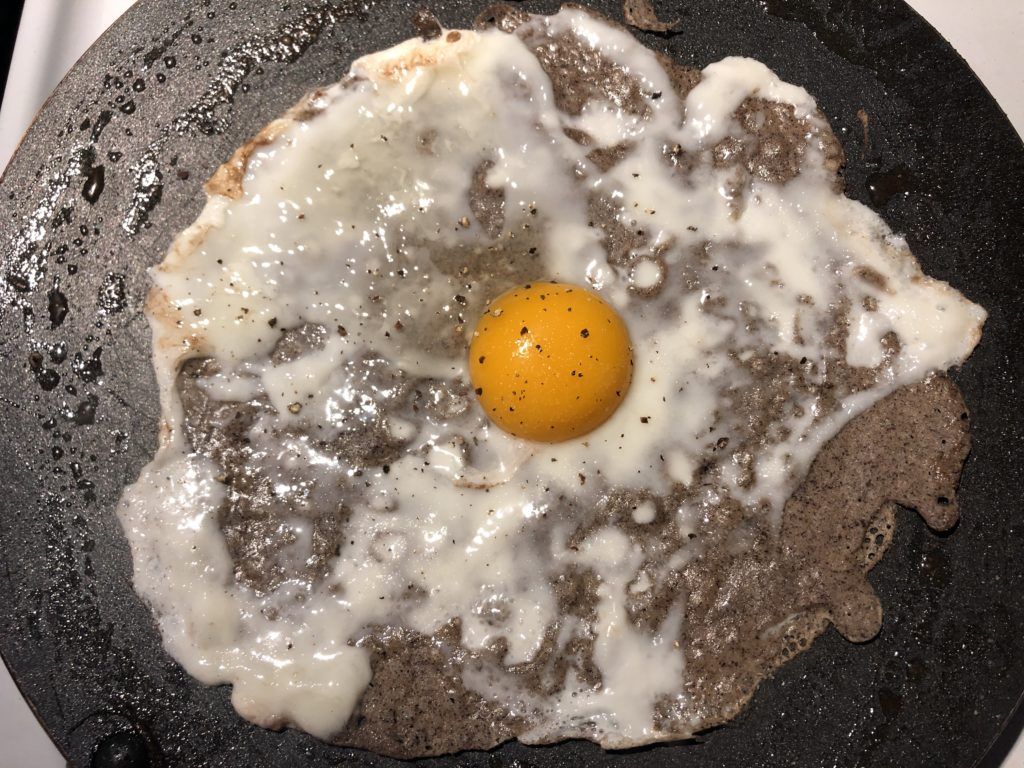Our weekly “À Table”dinner series gets its name from the mealtime call to the dining table. Since 2018, we have invited friends new and old to share a meal focusing on food, music and traditions from various places in the Francophone world. It has proved to be a fun way to connect with friends and practice our spoken French. Here on our site, we share portraits of some of our favorite meals so that you can easily do a version of the same chez vous Bon Appétit!
Transport yourself to Quimper, France for the Festival de Cornouaille, by recreating the experience at home with a playlist, a video sampling of the 2017 parade, and a recipe for making Galettes Bretonnes Complètes, just like you’d enjoy in Brittany. Cidre is optional but encouraged.
music
Celebrating Roots and Branches
One can get a sense of historical influence just by how the region is referred to: Brittany in English, Bretagne in French, and also Breton, in Celtic Brittonic.
The below video sampling of the 2017 Festival de Cornouaille parade provides a wonderful sampling of the music, costumes, and dances of the region heavily influenced by Celtic migration. It’s easy to hear and see the common threads in the music, dance, and costumes, even amidst all the uniqueness.
The rainy climate requires umbrellas to be an integral part of the dancing and parade. And a subsequent tradition evolved: most of the parade groups had a designated person wheeling a basket to hold the umbrellas when it wasn’t raining. See below.

And lastly, per the video, after the parade, you should do as the locals do and join friends for the very typical and extremely delicious Galettes Bretonnes Complètes. The recipe, an additional festival playlist, and more are captured here.
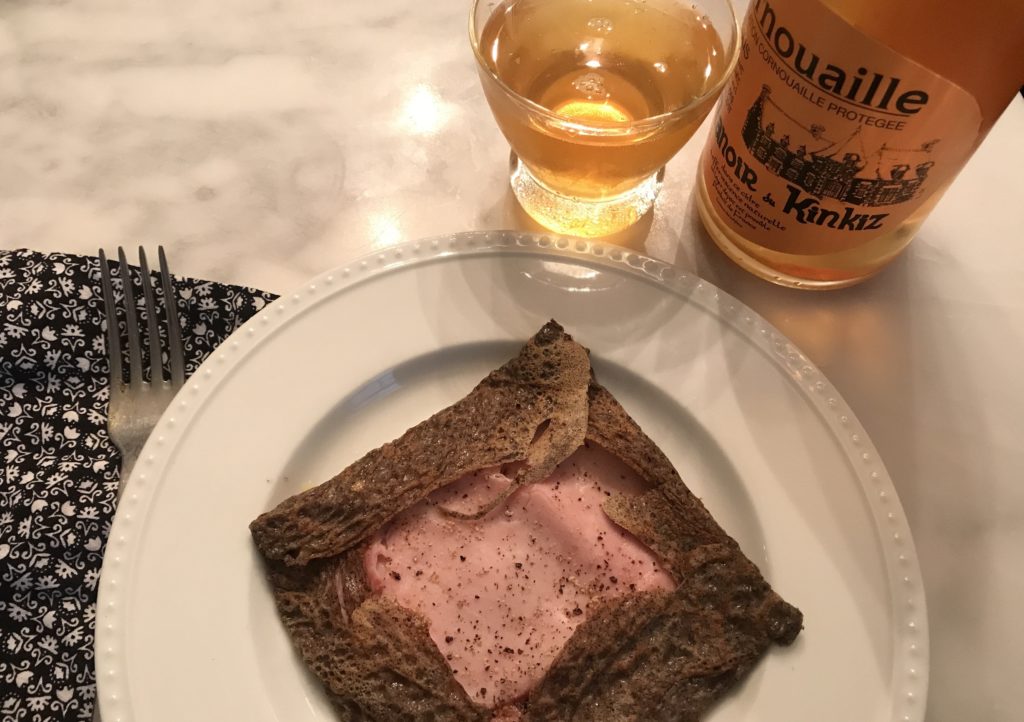
story
Marion Reflects
Marion and her family are friends from here in Brooklyn, but her hometown is Quimper (pronounced “kalm-pair”), where the Festival de Cornouaille takes place. When we were sharing our summer 2017 plans with her, and she realized we would be visiting friends in nearby La Forêt-Fouesnant, in late July, she became very excited, imploring us to join her and her family for the festival, and the tradition of post-parade crepes at her parents’ home.
She gushed about the music, traditions, and costumes, and about how much her own children love the festival. As lovers of food, music, and celebrating culture, particularly as it evolves, we were, of course, sold.
Below Marion reflects on why the festival is so special for her and her family:
“You know, it’s funny. I didn’t realize what a treasure it was until a friend from university returned with me to Quimper during the festival one year. When I was younger, I didn’t find it interesting at all, and I actually regarded the people who were into it as being too-Brittany, overly-obsessed with their culture.
However, when I had the opportunity to see the festival through the eyes of my friend from university, I began to see the richness, the simultaneous beauty of the collective culture of Brittany, and a uniqueness in the way the culture developed in various parts of the region. For example, when you go to the parade, you are able to see that the costumes have similarities across the regions, but there are also differences. Without knowing a detailed history of the region, your imagination will wonder if the wooden shoes worn by some groups were due to dutch settlers, and why some of the costumes have detailed embroidery, rich velvet fabric or intricate lace, and yet others will be very plain and peasant-like.
The parade is the grand finale but really the whole week is full of wonderful events. Early in the week is quite interactive and great for the whole family. From dance workshops to working with artisans with traditional handicrafts. There are activities and shows throughout Quimper all week, but the town square is the main focal point, with a large stage and many artisan booths set up nearby.”
Marion, on the festival
And once we confirmed, she added:
“This is so exciting! Now my kids, who already enjoy the festival, will get to experience what I did when I brought my friend from university to Quimper. In showing you and your kids about the rich culture of Breton, they will have the added benefit of seeing it through your kids’ eyes, making it all the richer to them. And afterwards, you’ll have to come back to my mum’s house for pancakes (how they refer to the Crèpes de Breton in English)! Just like I used to do in high school, bringing my gang back for pancakes. This is going to be great!”
Marion, continued

music
Playlist of Festival Favorites
Whenever we want a musical memory of our time in Brittany, we put on this Spotify playlist featuring favorite songs by performers we saw in 2017, as well as some from 2018 that we checked out from back in the States.
Enjoy as you cook and eat!
story
Les Galettes Bretonnes
Outside France, we tend to oversimplify this delicious food simply as “buckwheat crepes.” It is true that they resemble the shape and thinness of the textbook definition of crepes, and it is also true that buckwheat is a required ingredient. But recipes and terms vary throughout the region (thanks in part due to the multiple native languages of the area: French, Breton, and Gallo), and of course, the various cooking traditions that evolved in each area.
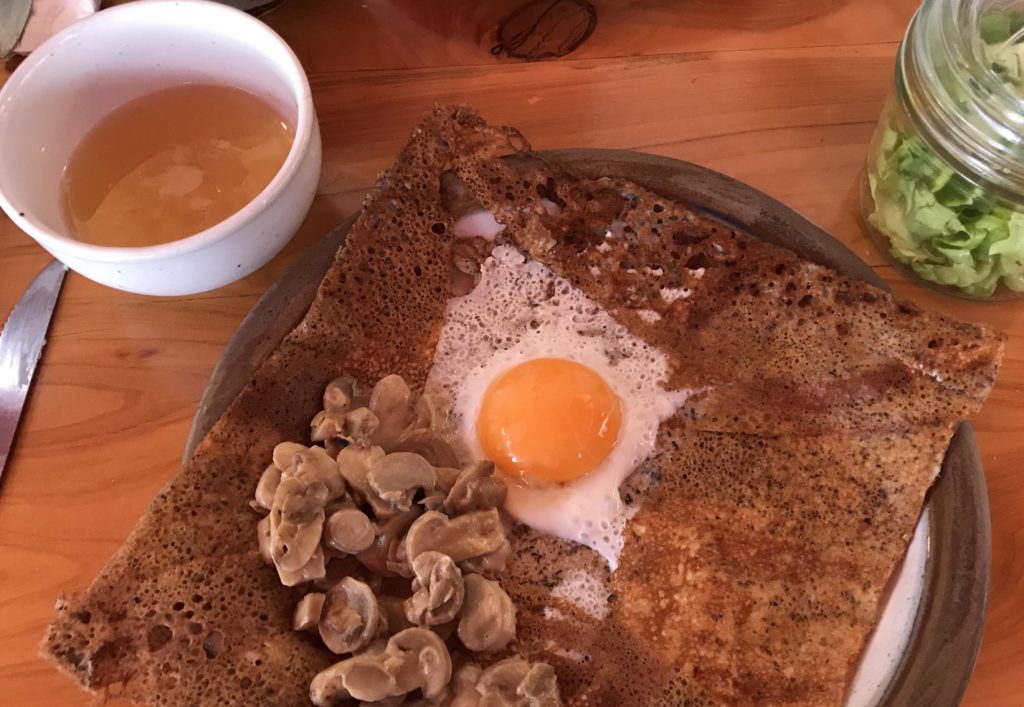
Here, we will refer to them as Marion does, as galettes, or Galettes Bretonnes Complètes, which also reflects how she refers to them in English: “pancakes.” You can, of course, dive into the French Wikipedia entry for Galette De Sarrasin, for a more academic report, but the point of this site is to capture the stories, foods, and music authentic to the people who share their stories, according to the terms and recipes true to them.
That said, there is more agreement around the qualifying term “complète” which refers to the standard way of enjoying them: filled with ham, egg, and cheese. Other classic versions include variations on those or sausage & apple, but endless options grace the table of families in Brittany.

The proper accompaniment for crèpes is cidre; a delicious hard cider made from apples or pears and is very common in the north of France. We recommend you pour yourself a glass while you start to cook. After all, it can help rid you of negative emotions, lest they add bitterness to your food!
recipe
Galettes Bretonnes Complète
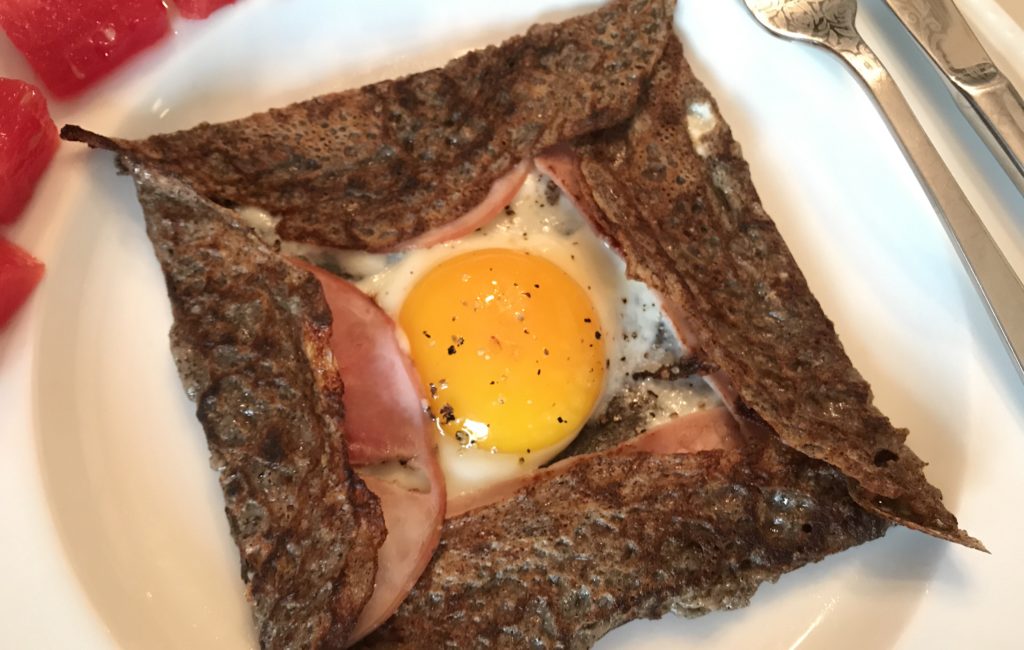
If you have buckwheat flour and a little patience, then these Galettes Bretonnes Complète will become a new favorite no matter where you are in the world. Don’t forget the cidre!
Below the recipe are some photos of the maman of my friend M, demonstrating the proper technique for shaping the galettes bretonnes complète.
Galettes Bretonnes Complètes (Buckwheat Crepes)
Ingredients
- 1 egg
- 1/2 cup Bob's Red Mill buckwheat flour* (500g)
- 1/2 cup all-purpose flour (500g)
- 1/2 cup salt
- 2 tbsp sunflower oil
- 2 cups start with 1 1/2 cup water, and increase to desired, surprisingly liquid consistency
- 1 tbsp butter (for the pan)
Choose your fillings and amounts per taste of your diners, but here is what we always have on hand:
- Sliced ham
- Eggs
- Emmental cheese
- Salami
- Sautéed mushrooms
Instructions
- At least one hour before planning to cook the galettes, prepare the batter: whisk one egg, then add both flours, salt, sunflower oil, and water to combine. Mixture should be very thin; about the consistency of cream or whole milk.
- Allow the batter to sit. [And have a cup of cidre with your guests. ;-)]
- When ready to cook the galettes, heat the crepe pan to medium heat, and rub butter around the pan.
- Holding the pan off the stove in one hand, scoop 1/3 cup of batter and pour it all around the pan, shifting the pan in your hand to ensure a thin coating and no holes.
- Let it cook, untouched until the sides start to brown. Meanwhile, depending on the type of filling (per notes above), put your filling in as the galettes cook.
- When the sides begin to brown, it is time to fold in 4 corners from your round(ish) crepe. Use the back of a knife (or other long flat utensil) to make a line in the edge of the galettes where you would like to fold it, then fold the edge in along that line. Repeat 3 more times, until you have a 4-sided square-ish shape.
- Serve immediately with additional salt and pepper, and of course, cidre.
Notes

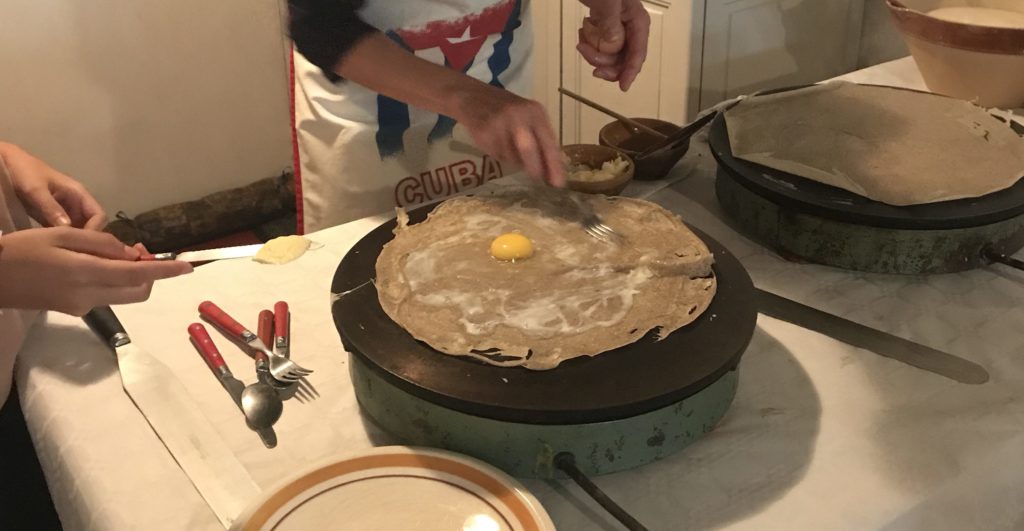

Bonus
Recipe Tips
Before you get to work, I’ll give you a few tips learned from many, many trials outside of France, where most of us do not have crepe griddles and the buckwheat available differs from that available in France.
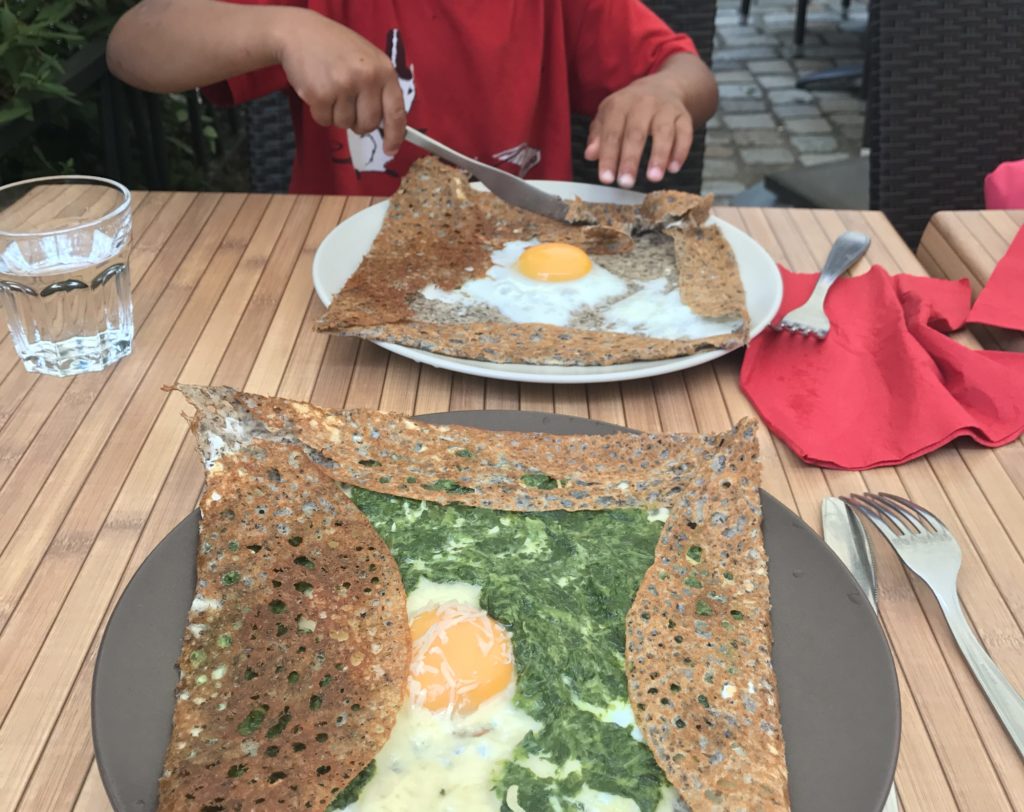
The recipe here is a composite of recipes from friends who grew up in Brittany (and their moms!), as well as several online, tweaked for products available in the US. Unlike some of the others I found online (in English and French) this recipe gets you to the taste of the galettes you will enjoy in homes and creperies in Brittany.
The main difference is the variances in flour, but there are some other things to keep in mind, too:
- Flour: The buckwheat flour itself is different here in the US (and likely elsewhere), than in France (where it is known as “Farine de sarrasin”). There are also variations by brand, depending on the inclusion of the hulls in the processing of the buckwheat seed, which changes both the consistency and color of the flour.
If you use Bob’s Red Mill, it seems to have the hulls in it, which leads to the purple-ish flecks and lends it a purple hue. It does provide more depth of flavor and color, but to mimic what you will find on tables in Brittany, you should cut it with all-purpose flour.
That said, if you use a buckwheat flour that does not have visible purple flecks in it, (like that of Arrowhead Mills), you should not cut it with all-purpose flour. This buckwheat already has a less complex taste, so cutting it will further decrease the depth of flavor buckwheat is so wonderful for.
In summary: if the flour doesn’t have purple flecks in it, then you shouldn’t cut it with all-purpose flour. If it does have purple flecks you should cut it, up to 50% with all-purpose flour. - Preparation: The batter works best when the buckwheat has some time to absorb the water, so it’s best to let it sit for an hour before cooking.
- Pan: It helps to have a thin, flat, nonstick pan without edges. I tried it on a double-burner and couldn’t get it to work correctly. I had the best luck on our dosa pan because I would lift up the pan to have the thin batter distribute evenly (not swirl it with a crepe spreader as grand-mere did… somehow couldn’t get the hang of that).
- Patience: Don’t even think about flipping it until you’ve got a bit of a crust on the bottom.
- Filling types: Standard for complète would be the ham, then egg and Emmental cheese as listed, but by all means get creative! Our kids like only egg or only salami, and I love sautéed mushrooms and Emmental. For each complète , you would need one egg, 1-2 pieces of ham, and 1-2 thin slices of cheese.
- Eggs: Here in the US, eggs tend to be larger, and the size of the pans smaller, so the egg will take a good amount of time to set. Therefore, put the egg onto the crepe almost immediately upon setting it on the pan, and spread out the white with a fork to help it cook (see the photo below, as well as the second photo of Marion’s mom). It’s unorthodox, but I’ve also cooked the egg separately and put it atop the crepe for those who like their egg cooked more thoroughly.
